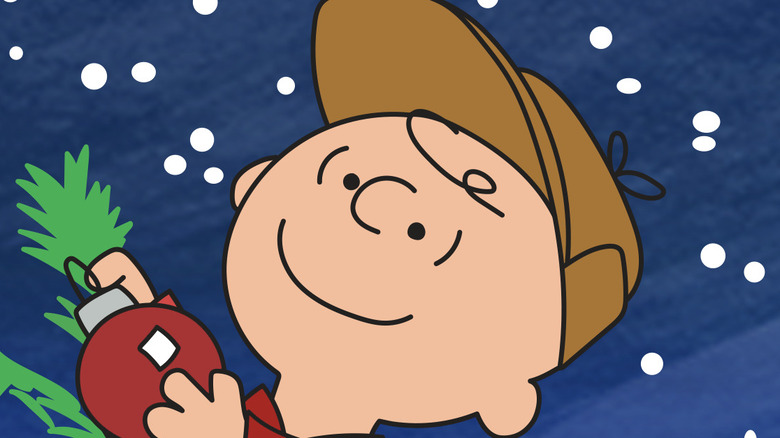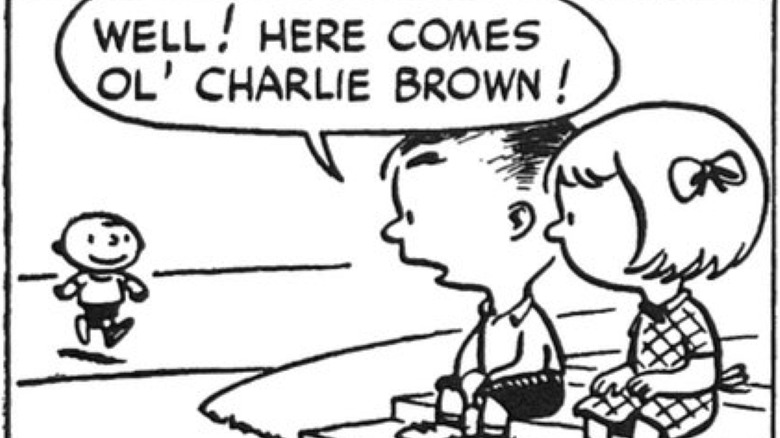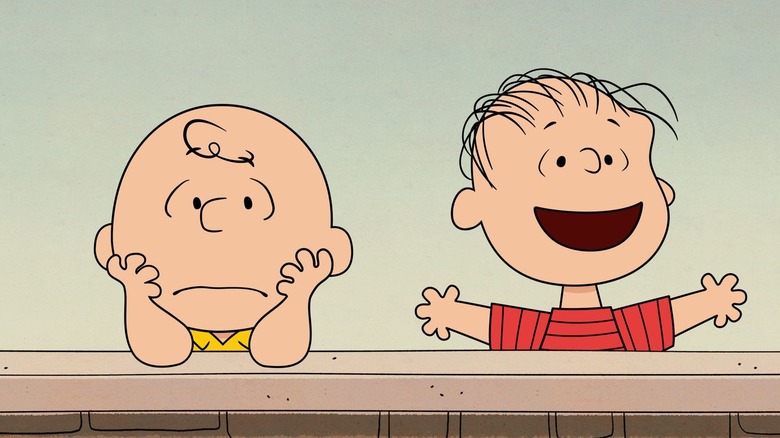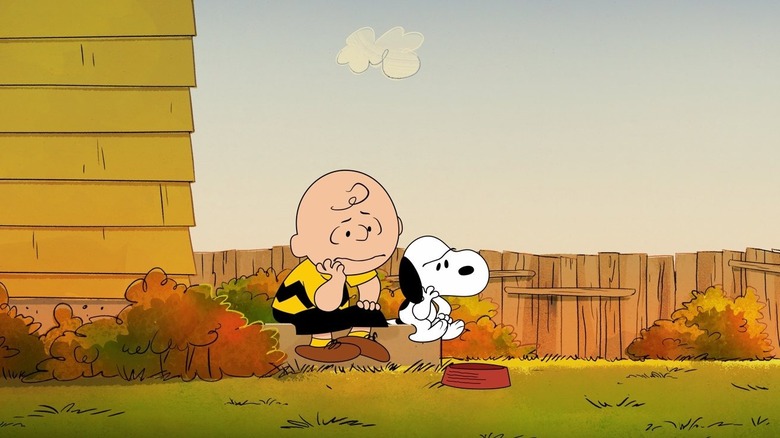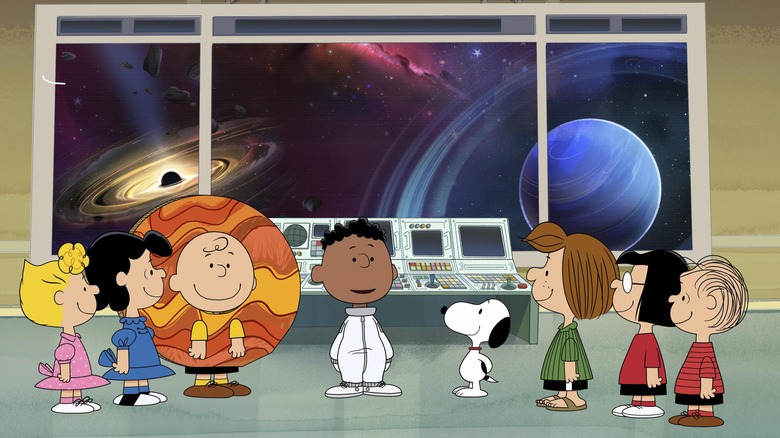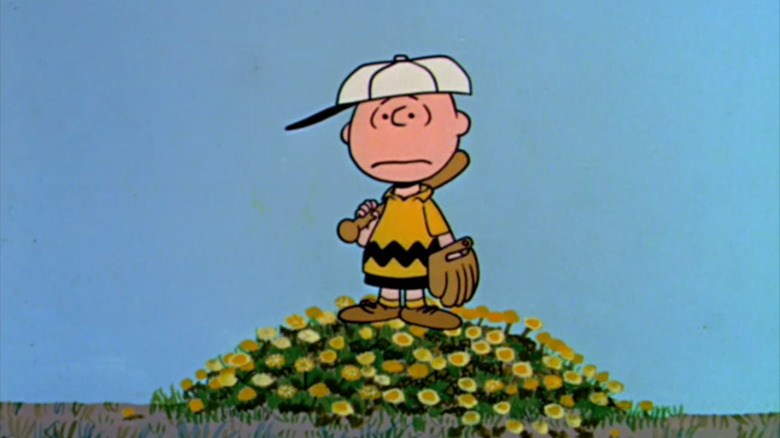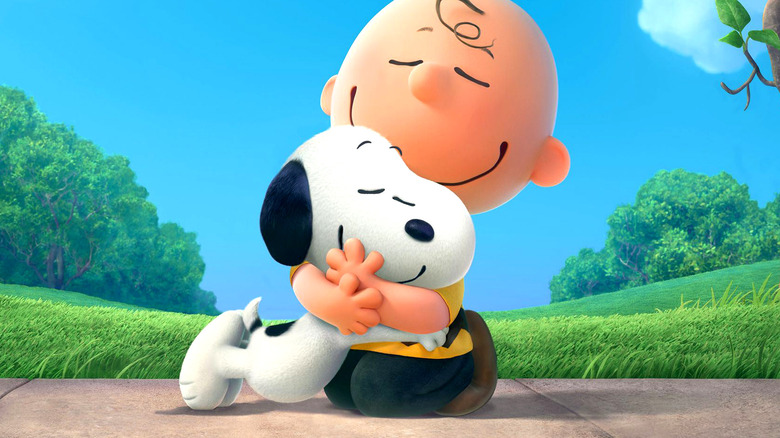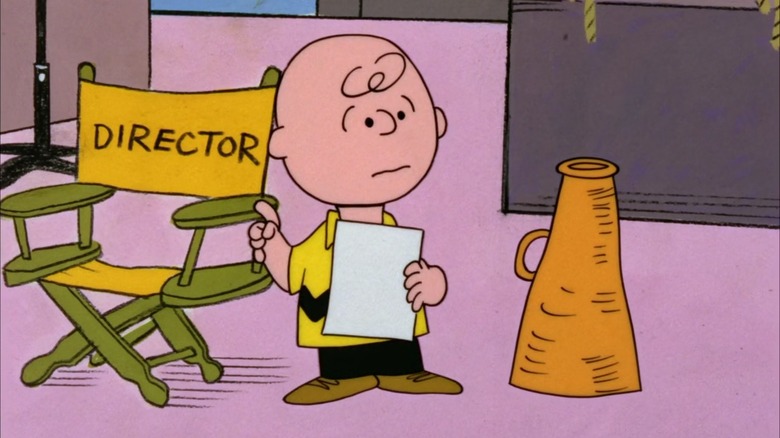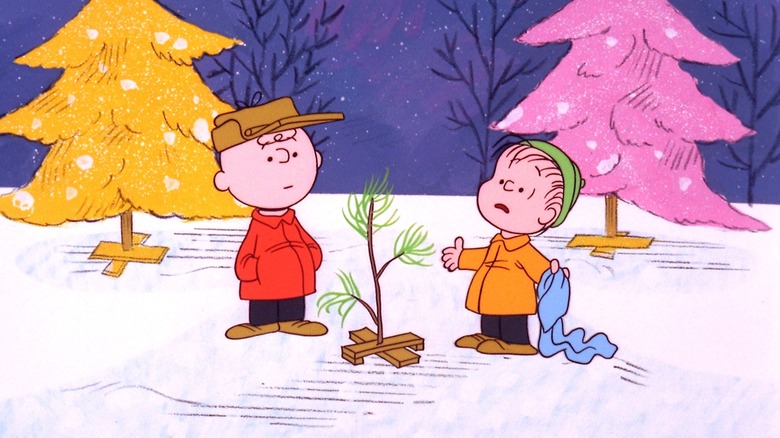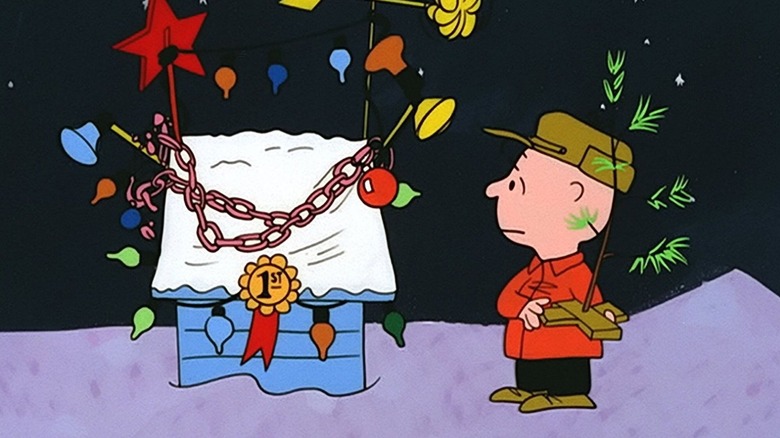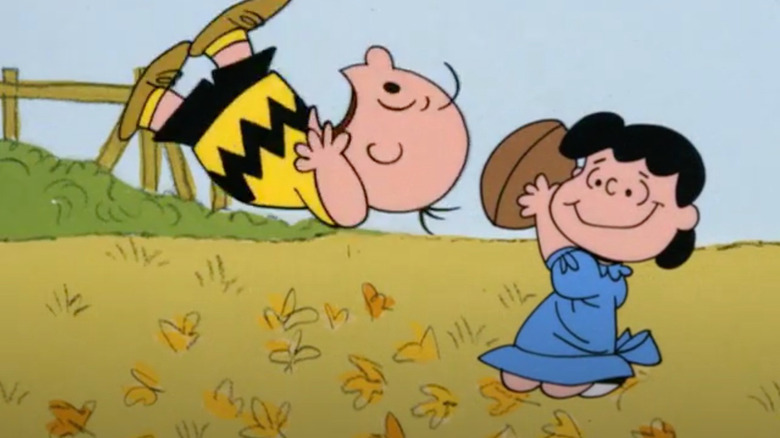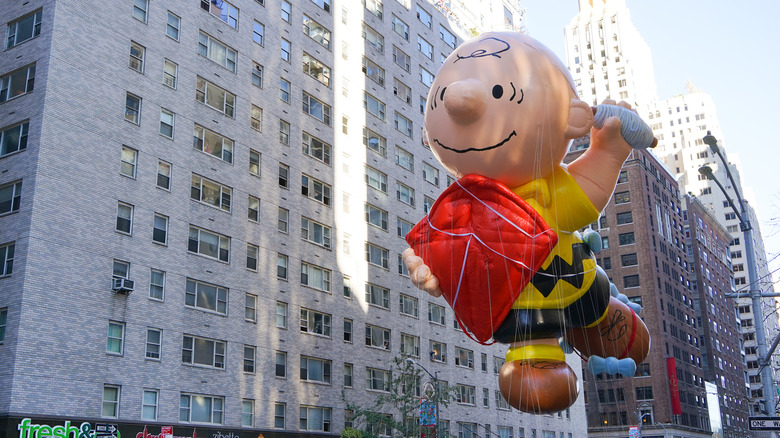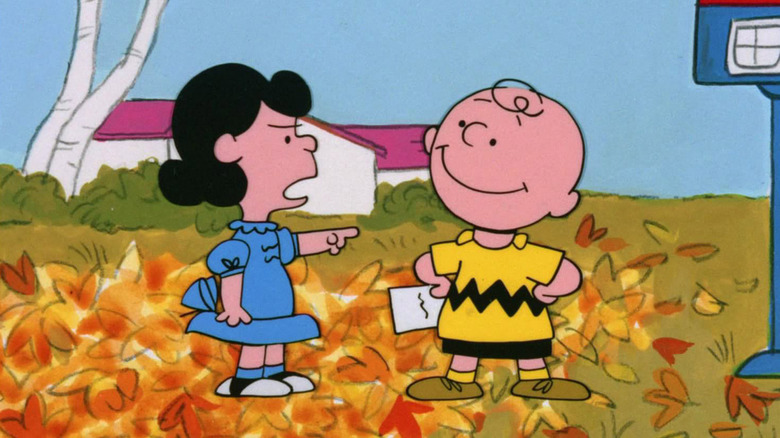The Untold Truth Of Charlie Brown
At the beginning of "A Charlie Brown Christmas," Charlie Brown complains that he doesn't feel happy during the jubilant Christmas season, leading his pal Linus van Pelt to observe that only Charlie Brown could turn this season of joy into an issue. "Maybe Lucy's right," Linus muses. "Of all the Charlie Browns in the world, you're the Charlie Brown-iest."
Charlie Brown certainly isn't shy about the personality traits everyone associates with this character, particularly a pessimistic outlook forged in the fires of (in his mind) relentless disappointment. But this kid's struggles have also made him a deeply relatable figure to audiences worldwide for decades. There isn't another character in comics, TV specials, or movies quite like Charlie Brown, an adolescent who goes through woes we all experience while demonstrating a tenacity we all wished we had.
These qualities of Charlie Brown are the ones that everyone's aware of, but what about the less famous elements of the character? Charlie Brown's little-known history includes everything from details about his earliest days in the "Peanuts" comic strip to his translation into a wide variety of media forms since his beginnings in 1950. Only the "Charlie Brown-iest" Charlie Brown of them all could inspire an untold truth this rich and interesting.
Charlie Brown was in Peanuts from the very beginning
People reading the "Peanuts" comics in chronological order for the first time may be surprised to discover that some of the property's most iconic figures were not originally a part of it. While eventually-discarded characters like Shermy and Patty were established in the very first "Peanuts" comics, it took a few days before Charles M. Schulz introduced a canine by the name of Snoopy. Other pivotal "Peanuts" figures like Schroeder, Lucy, and Linus would take a couple of years to get introduced — a reflection of how much "Peanuts" evolved as it went along.
However, good ol' Charlie Brown was there from the very first comic, though he was wearing a plain white shirt instead of his famous yellow shirt with a black zig-zag. In his debut appearance, Brown saunters across the first frame, causing Shermy to observe, "Well! Here comes ol' Charlie Brown!" Initially speaking fondly of Brown while he's within earshot, the moment Brown has walked away, Shermy remarks to Patty, "How I hate him!" It was a brutal sequence that not only introduced Charlie Brown to readers, it also established the unflinching humor (often at Brown's expense) that the character would be surrounded by for so much of his existence.
How Charlie Brown evolved in the comics
Considering the punchline of the very first "Peanuts" comic was about how Shermy "hated" Charlie Brown, it's apparent that this character was an underdog from the moment he entered pop culture. But that doesn't mean Charlie Brown's every trait was solidified from the very beginning. In fact, the earliest "Peanuts" comics would strike people today as odd due to Charlie Brown's dramatic deviation from his modern-day counterpart. For example, his dynamic with Lucy was very different early on. The rapport between the two characters now famously features Lucy acting sneaky and malicious towards Brown. Initially, though, Lucy is introduced as a young child to whom Brown serves as a helpful older brother.
This is just one way the earliest "Peanuts" comics differed in terms of Charlie Brown's personality. Brown is also seemingly capable of picking on other kids in the earliest years of "Peanuts" and is regularly seen at social events with his peers. This is a sharp contrast to the meeker version of the character who feels depressed during Christmastime and is laughed at by others for picking out a scrawny Christmas tree. It wouldn't be long before "Peanuts" figured out which direction to take Charlie Brown. However, the comic's early evolution offers a peek at an alternate version of this seminal character.
The character was partially inspired by Charles M. Schulz
Charlie Brown and "Peanuts" creator Charles M. Schulz have a lot in common, even beyond sharing a first name. Schulz once said, when asked which "Peanuts" character he most resembled, that he was "mainly Charlie Brown." This similarity comes through in Brown's personality, which is just as prone to fits of nervousness as its writer's, as well as how they both had childhood crushes on redheads. However, perhaps the most important overlapping trait is found in Brown's home life — specifically, in the occupation of the character's father.
Throughout the run of the "Peanuts" comic and in a handful of TV specials, Charlie Brown remarks upon how his dad works as a barber. It's a job that Brown admires him for sticking to, and the lack of extravagant glamor surrounding the duty serves as an extension of Brown's grounded nature. However, the profession is also a nod to how Schulz's father, Carl Schulz, also worked as a barber, as well as how Schulz had a similar respect for his dad. Though he went into a different line of work himself, Schulz conveyed his attitude towards his father, not to mention solidified the parallels between himself and Charlie Brown, by working a barber into "Peanuts" lore.
The Peanuts and the Apollo 10 mission
For the most part, the adventures of Charlie Brown and friends in the "Peanuts" comics and TV specials are grounded stories. Extravagant dogfights or more elaborate storylines are limited to flights of fantasy in the head of Snoopy when he's on top of his doghouse. Otherwise, these characters have their feet firmly planted on the ground. However, that doesn't mean projects outside the comics couldn't take Charlie Brown somewhere as extraordinary as outer space. This is what (technically) happened in May 1969, when Apollo 10 launched with a command module named Charlie Brown.
As noted by the Kennedy Space Center's official website, this decision actually originated from the fact that the lunar module for Apollo 10 was named Snoopy, as a tribute to that famous beagle and because the vehicle would "snoop" around the moon to gather information for future landings. With one "Peanuts" character already involved in the Apollo 10 mission, it was only natural that the command module would receive the moniker of Snoopy's companion, Charlie Brown.
To celebrate the union between Charlie Brown and space exploration, members of mission control put toy models of Charlie Brown and Snoopy atop their consoles, while Charles M. Schulz penned comic strips depicting Snoopy imagining himself as the first astronaut to make it the Moon. ("I even beat that stupid cat next door!" Snoopy says triumphantly.)
The various Charlie Brown voice actors
Until the 1960s, Charlie Brown, as a character, was restricted to the funny pages of your local newspaper. Here, the character had no voice beyond the one the reader gave him. But when it came time for Charlie Brown to headline TV specials in the decade of counterculture, that would change. Peter Robbins served as the very first voice actor for the character starting with "A Charlie Brown Christmas," but he wouldn't be the last. After he played Brown for the last time in 1969, it wouldn't be long before a trove of other actors took on the part.
Over the years, actors like Chad Allen and Justin Shenkarow have all played the character in various movies, TV specials, and TV shows. Interestingly, among the most high-profile of these voiceover performers in the character's decades-long history arrived in the 2015 feature "The Peanuts Movie." Here, the character was played by Noah Schnapp, who, just eight months after "The Peanuts Movie" hit theaters, would receive a substantial increase in notoriety for his role as Will Byers on "Stranger Things." This is just one of countless notable elements found in the legacy of Charlie Brown's voice actors.
The source of Charlie Brown's appeal, according to The Peanuts Movie director
Charlie Brown is such an indispensable pop culture icon that it can sometimes be difficult to remember how he rose to that stature in the first place. What's behind Charlie Brown's lasting appeal as a centerpiece of everything from Broadway musicals to TV specials? Is his popularity simply buoyed by nostalgia for the pop culture properties people watch every year around the holidays? Or is there something deeper underpinning people's fondness for the role? If you ask "The Peanuts Movie" director Steve Martino, it's very much the latter.
Martino explained to The Washington Post that what makes Charlie Brown such a persistently lovable character is his inability to give up. No matter how many times he makes a fool of himself, how many kites he crushes, or how many baseball games he loses, Charlie Brown always gets out of bed and focuses on a new day. For Martino, this endurance made Charlie Brown an everyman figure that was every bit as inspirational as powerful superheroes or wealthy pop stars. That resilience didn't just inform Martino's approach to realizing Charlie Brown in "The Peanuts Movie," it also encapsulates, for him, what makes Charlie Brown a character we all can't get enough of.
Why the now-classic Christmas special was initially a gamble
Today, "A Charlie Brown Christmas" has proven so enduringly popular that it feels like a no-brainer to build a TV special around Charlie Brown and his pals. But back in the mid-1960s, there had been no prior "Peanuts" TV specials, and "A Charlie Brown Christmas" was looking like a big risk for all involved. Part of what made it seem like such a gamble was Brown himself. This adolescent was seen as a difficult character around which to center an entire holiday special.
It's not necessarily that the character was seen as too melancholy to headline a TV special aimed at kids. Rather, as reported by Smithsonian Magazine, various outlets in 1965 reported a growing sentiment that audiences had grown accustomed to imagining how Charlie Brown and friends moved and sounded through reading the "Peanuts" comic for years. To tamper with that existing conception by translating Charlie Brown to TV, where these viewers could no longer control the characters, was seen as a gamble that could jeopardize the entire "Peanuts" empire.
These initial concerns turned out to be pointless, of course, since "A Charlie Brown Christmas" had no problem becoming an annual TV staple and proved to be just as influential as its source material. The risks associated with bringing Charlie Brown to TV were worth it.
The pitiful Christmas tree parallels Charlie Brown
One of the standout visuals in "A Charlie Brown Christmas" comes halfway through the special when Charlie Brown and Linus van Pelt go searching for a Christmas tree for the school play. While wandering through aluminum Christmas trees, the duo soon discovers something organic hiding among all the artificiality: a small, scrawny, but real Christmas tree. Ignoring the concerns of van Pelt, Brown brings the tree back to the school, where it's derided as worthless by the other kids. Eventually, though, everyone comes around to the tree's usefulness, and the special ends with the characters singing a song around the sparsely decorated piece of foliage.
This tree is already a memorable part of "A Charlie Brown Christmas" on its own. However, there's a deeper meaning to this plant, according to USA Today. The tree isn't just another instance of Charlie Brown looking out for an underdog: It's meant to be a parallel to the child himself. Neither the tree nor Charlie Brown appears that impressive on the outside, but both prove to be perfect vehicles for spreading holiday cheer by the end of "A Charlie Brown Christmas." What a fitting symbol for this iconic character.
The Christmas TV tradition
"A Charlie Brown Christmas" is by far the most famous Charlie Brown property centering around Christmas. However, it's not the only time this character has encountered the holiday. After decades of exploring other holidays and even non-festive storylines in an assortment of TV specials, it was inevitable that Charlie Brown would return to the subject matter that defined his first foray into television.
Thirty years after "A Charlie Brown Christmas" first hit the airwaves, "It's Christmastime Again, Charlie Brown" continued the legacy. A compilation of various Yuletide-themed storylines, this special primarily differentiated itself from "A Charlie Brown Christmas" through its anthology style of storytelling. Another distinguishing quality was that "It's Christmastime Again, Charlie Brown" utilized characters like Woodstock, Franklin, and Peppermint Patty, who hadn't yet been introduced when "A Charlie Brown Christmas" premiered in 1964.
In the 21st century, "Charlie Brown's Christmas Tales" would serve as the third Christmas-themed "Peanuts" adventure in 2002, while the following year would deliver "I Want a Dog for Christmas, Charlie Brown." This special shifts the focus of the proceedings from Charlie Brown to Rerun van Pelt, who yearns for a canine like Snoopy as a Christmas present. Charlie Brown's deep connection to Christmas on television even extends to the age of streaming, with the character's first Apple TV+ special, "For Auld Lang Syne," premiering in mid-December 2021. At this point, you can't separate the character from Yuletide merriment.
Where did the football gag come from?
One of the most iconic qualities associated with Charlie Brown is his inability to kick a football — at least, any football set up by Lucy van Pelt. The image of him stumbling (and Lucy grinning) after these failed attempts has endured as one of the most famous motifs of this character. Treated as something of an annual tradition in the 50-year run of the "Peanuts" comic, Charlie Brown's struggles with that football arguably rose in prominence thanks to the power of the small screen. TV specials like "It's the Great Pumpkin, Charlie Brown" and "A Charlie Brown Thanksgiving" utilize this scuffle for memorable comedic sequences that work better in motion than on the page.
While most people are well aware of this running joke, the origins of Lucy pulling away the football are less well-known. A history of this recurring gag by Slate recalls its first occurrence in 1953 when Lucy fails to hold up a football properly for Charlie Brown. While more recognizable instances of this gag conclude with Brown appearing forlorn after missing the ball, this original version of the dynamic, if you can imagine it, shows Brown reacting with rage towards Lucy. From there, the joke kept returning in the "Peanuts" comic, but with the characters' motivations changed to emphasize Charlie Brown's "eternal underdog" nature.
That time Charlie Brown went to Broadway
Someone as popular as Charlie Brown can't be confined to one medium forever. It was only a matter of time before this comic strip character found his way into other creative mediums, like television specials or animated feature films. Brown's prominence in pop culture even extended to productions involving flesh-and-blood humans with a stage musical entitled "You're a Good Man, Charlie Brown."
This piece began an off-Broadway run in 1967 before transitioning to a 1971 iteration on Broadway with an array of songs written by Clark Gesner. Despite being based on a group of extremely beloved characters, the project only lasted for 32 performances. However, the enduring popularity of Charlie Brown continued for so long that "You're a Good Man, Charlie Brown" itself started getting revived in different forms, including an adaptation into a TV special of the same name in 1986.
Over a decade later, "You're a Good Man, Charlie Brown" returned to its roots by scoring a revival on Broadway in 1999 with a cast that included BD Wong as Linus and Kristin Chenoweth as Sally. Though this version of the musical received mixed marks, it hasn't stopped "You're a Good Man, Charlie Brown" from getting performed in local theater programs. Charlie Brown may be a blockhead, but there's no denying he can headline a musical that manages to endure.
The lengthy television run of Charlie Brown
When "A Charlie Brown Christmas" first hit TV airwaves, it premiered on CBS. This network would remain the program's home until the 21st century when ABC procured the broadcast rights to the holiday special: Forty years after its inaugural airing, "A Charlie Brown Christmas" was still a big enough seasonal viewing staple to garner the interest of ABC executives, and its popularity lasted long after this acquisition. As late as 2018, "A Charlie Brown Christmas" emerged as the most-watched TV show the night it aired in the crucial 18-49 demographic. Rather than a relic kept around out of a sense of tradition-fueled obligation, "A Charlie Brown Christmas" was still a ratings juggernaut.
Charlie Brown's legacy as a television icon hit a major speed bump in 2020. This was the year Apple TV+ purchased the broadcast rights to all "Peanuts" specials, including "A Charlie Brown Christmas," and made them exclusive to the streaming platform (save for the holiday specials getting a few brief appearances on PBS stations). Given how long Charlie Brown had been a staple of broadcast television, this development generated an abundance of controversy. Though he no longer inhabits CBS nor ABC, the fact that Charlie Brown spent more than half a century with his holiday exploits featured by two major broadcast networks is a remarkable accomplishment.
